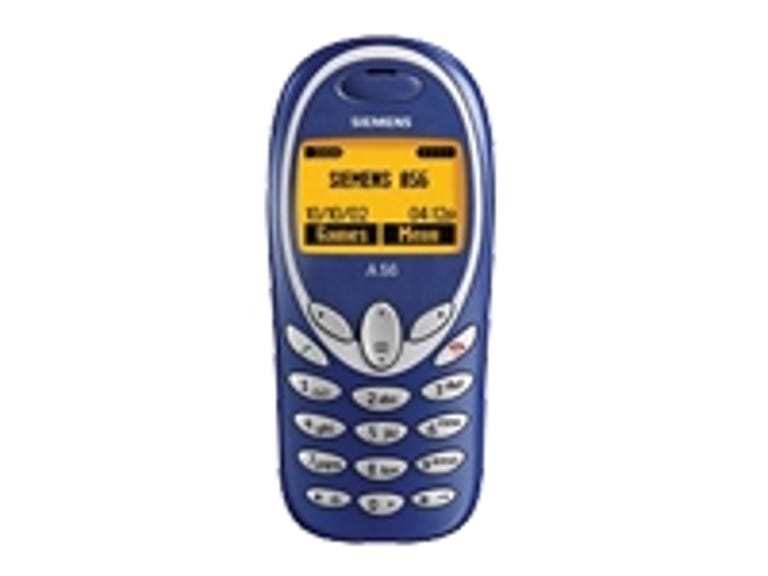 Why You Can Trust CNET
Why You Can Trust CNET Siemens A56 (Cingular) review: Siemens A56 (Cingular)
Siemens A56 (Cingular)
Intro
Like its cousin, the CT56, Siemens's A56 GSM handset delivers strong call quality with a limited feature set. The main difference between the units is that the A56 doesn't have a speakerphone or support for J2ME, so you can't download applications or games. But customers looking for an entry-level mobile phone will find this a serviceable unit. Although it features the same small footprint as the CT56--weighing 3 ounces and measuring 4 by 1.7 by 0.8 inches--the A56 sports a slightly more rounded look. The buttons are small but raised sufficiently for easy dialing. If you don't like the phone's blue faceplate, you can swap it out for another ClipIt model.
The menu system is so easy that you need only the two-way navigation key to wade through its structure. Unfortunately, this button also doubles as the earpiece/speakerphone volume control; we prefer those controls to be placed on the side of the unit for easy adjustment during calls.
Inserting and removing the required SIM card can be a tricky affair. The card has a tendency to spring itself out of the unit instead of merely popping up when you're trying to remove it. During insertion, it helps if you have sharp nails to close the latch that secures the card.
For operation, the A56 requires a SIM card, on which you store all your contacts; ours came with a capacity of 250 entries. You can also store up to 50 entries on the phone itself, although you can't view those contacts without the SIM card. The A56 has all the other features you'd expect, such as two-way SMS, voice-activated dialing and commands, wireless Web access, an alarm clock, a calculator, and games. Unlike the CT56, the A56 supports only monophonic ring tones, but you can choose between 25 tunes or a vibrate mode, as well as download more tones. Since the mobile supports EMS, you can also download images to the phone for more customization.
As with the CT56, the A56 won't let you maintain a running tally of your call usage. The only way you can tell how long you've been on your current call is to take the handset away from your face and click the menu button. We wish that it would display the elapsed time on the screen during the call by default.
We tested the GSM (850/1900) phone in the Chicago area. As with all Cingular phones, if you move out of range of the company's network, you're automatically switched to AT&T Wireless or T-Mobile, depending on your location. Aside from occasional dropouts, the call quality was superb on both AT&T Wireless and T-Mobile networks, with rich bass tones and little or no static. Callers also commented on how clear we sounded.
We managed to get nearly 4 hours of talk time on a single charge--short of the maximum rating of 5 hours but solid, nonetheless. The battery's standby time, however, was only 70 hours, while Siemens rates it at up to 250 hours. Such times are network dependent, and we suspect our abbreviated standby time was due to the fact that we were out of Cingular's range and had to access the alternate networks.
Like its cousin, the CT56, Siemens's A56 GSM handset delivers strong call quality with a limited feature set. The main difference between the units is that the A56 doesn't have a speakerphone or support for J2ME, so you can't download applications or games. But customers looking for an entry-level mobile phone will find this a serviceable unit. Although it features the same small footprint as the CT56--weighing 3 ounces and measuring 4 by 1.7 by 0.8 inches--the A56 sports a slightly more rounded look. The buttons are small but raised sufficiently for easy dialing. If you don't like the phone's blue faceplate, you can swap it out for another ClipIt model.
| "="" --="">/sc/20853920-2-200-DT1.gif" width="200" height="150" border="0" /> Pocket-friendly: This compact mobile won't take up a lot of room. |
Inserting and removing the required SIM card can be a tricky affair. The card has a tendency to spring itself out of the unit instead of merely popping up when you're trying to remove it. During insertion, it helps if you have sharp nails to close the latch that secures the card.
| "="" --="">/sc/20853920-2-200-DT2.gif" width="200" height="150" border="0" /> Load it up: The headset and the belt clip may not be included, but they're worthwhile additions. |
As with the CT56, the A56 won't let you maintain a running tally of your call usage. The only way you can tell how long you've been on your current call is to take the handset away from your face and click the menu button. We wish that it would display the elapsed time on the screen during the call by default.
| "="" --="">/sc/20853920-2-200-DT3.gif" width="200" height="150" border="0" /> Charge it up: The A56 recharges quickly. |
We managed to get nearly 4 hours of talk time on a single charge--short of the maximum rating of 5 hours but solid, nonetheless. The battery's standby time, however, was only 70 hours, while Siemens rates it at up to 250 hours. Such times are network dependent, and we suspect our abbreviated standby time was due to the fact that we were out of Cingular's range and had to access the alternate networks.
Score Breakdown
Design 6Features 6Performance 7
